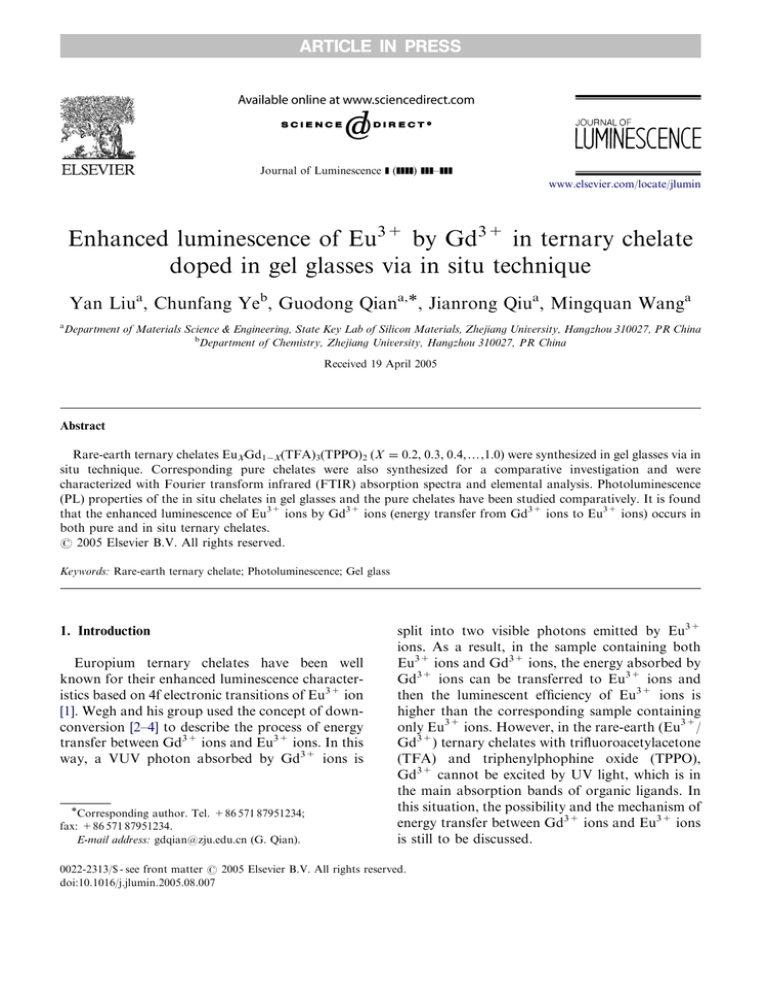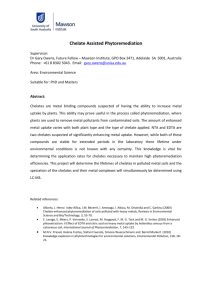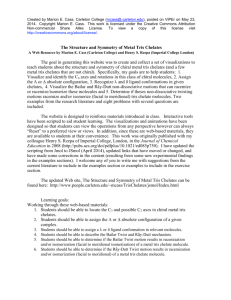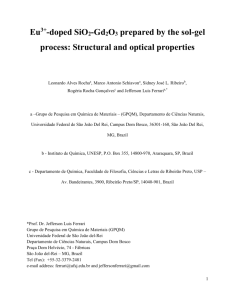
ARTICLE IN PRESS
Journal of Luminescence ] (]]]]) ]]]–]]]
www.elsevier.com/locate/jlumin
Enhanced luminescence of Eu3+ by Gd3+ in ternary chelate
doped in gel glasses via in situ technique
Yan Liua, Chunfang Yeb, Guodong Qiana,, Jianrong Qiua, Mingquan Wanga
a
Department of Materials Science & Engineering, State Key Lab of Silicon Materials, Zhejiang University, Hangzhou 310027, PR China
b
Department of Chemistry, Zhejiang University, Hangzhou 310027, PR China
Received 19 April 2005
Abstract
Rare-earth ternary chelates EuXGd1X(TFA)3(TPPO)2 (X ¼ 0:2, 0.3, 0.4,y,1.0) were synthesized in gel glasses via in
situ technique. Corresponding pure chelates were also synthesized for a comparative investigation and were
characterized with Fourier transform infrared (FTIR) absorption spectra and elemental analysis. Photoluminescence
(PL) properties of the in situ chelates in gel glasses and the pure chelates have been studied comparatively. It is found
that the enhanced luminescence of Eu3+ ions by Gd3+ ions (energy transfer from Gd3+ ions to Eu3+ ions) occurs in
both pure and in situ ternary chelates.
r 2005 Elsevier B.V. All rights reserved.
Keywords: Rare-earth ternary chelate; Photoluminescence; Gel glass
1. Introduction
Europium ternary chelates have been well
known for their enhanced luminescence characteristics based on 4f electronic transitions of Eu3+ ion
[1]. Wegh and his group used the concept of downconversion [2–4] to describe the process of energy
transfer between Gd3+ ions and Eu3+ ions. In this
way, a VUV photon absorbed by Gd3+ ions is
Corresponding author. Tel. +86 571 87951234;
fax: +86 571 87951234.
E-mail address: gdqian@zju.edu.cn (G. Qian).
split into two visible photons emitted by Eu3+
ions. As a result, in the sample containing both
Eu3+ ions and Gd3+ ions, the energy absorbed by
Gd3+ ions can be transferred to Eu3+ ions and
then the luminescent efficiency of Eu3+ ions is
higher than the corresponding sample containing
only Eu3+ ions. However, in the rare-earth (Eu3+/
Gd3+) ternary chelates with trifluoroacetylacetone
(TFA) and triphenylphophine oxide (TPPO),
Gd3+ cannot be excited by UV light, which is in
the main absorption bands of organic ligands. In
this situation, the possibility and the mechanism of
energy transfer between Gd3+ ions and Eu3+ ions
is still to be discussed.
0022-2313/$ - see front matter r 2005 Elsevier B.V. All rights reserved.
doi:10.1016/j.jlumin.2005.08.007
ARTICLE IN PRESS
Y. Liu et al. / Journal of Luminescence ] (]]]]) ]]]–]]]
2
In present paper, rare-earth (Eu3+ and Eu3+/
Gd3+) ternary chelates with TFA and TPPO,
EuXGd1XTFA-TPPO (X ¼ 0:2, 0.3, 0.4,y,1.0),
were synthesized as well as the ternary chelates
doped in gel glasses via in situ technique. Pure
chelates have been characterized and photoluminescence (PL) spectra of both the pure ternary
chelates and the chelates dispersed in gel glasses
have been measured. PL spectra indicate that the
sensitized luminescence of Eu3+ ions by Gd3+
ions occurs in Eu/Gd ternary chelate.
2. Experimental details
2.1. Sample preparation
The possible chemical structure of rare-earth
ternary complexes, EuXGd1X(TFA)3(TPPO)2
(X ¼ 0:2, 0.3, 0.4,y,1.0), is given in Fig. 1 [5].
The molar ratios of rare earth: TFA: TPPO and
Eu3+: Gd3+ are 1:3:2 and X: 1X, respectively.
The following statement describes the detailed
preparation of pure chelates. TFA and TPPO were
dissolved in absolute ethanol and NaOH was
added to neutralize the acidity of the solution until
pH ¼ 7. EuCl3 and GdCl3 dissolved in distilled
water were dropped slowly with stirring. Excessive
distilled water was added until no more precipitation occurred.
The chelate-doped gel glasses were prepared by
hydrolysis-condensation of the vinyltriethoxysilane (VTES) precursors as described previously
[6]. The initial molar ratios of VTES: ethanol:
water was 1:3:3. Acid hydrolysis was performed
with HCl as catalyst and ethanol as solvent. After
several hours of hydrolysis, a small amount of
basic-catalyst 3-aminopropyltriethoxysilane was
added to neutralize the acidity of the sol thereby
CH3
2.2. Measurements
Elemental analysis data was obtained by EA
1110 CHNS-O ThemoQuest CE Instruments. The
FTIR absorption spectra were measured with a
Nicolet AVATAR 360 FT-IR spectrometer. The
PL spectra were taken by an SP-750 monochromator, a PMT and an NCL multi-channel data
collecting analysis system. The sample was excited
by the emission line at 355 nm from the third
harmonic of Xe-lamp pumped Q-switched Nd:
YAG laser with pulse width of 25 ns and beam
diameter of 1.5 mm. The pump repetition rate
could be adjusted from single shot to 20 Hz.
3. Results and discussion
O
Ln
O
P
O
CF3
to increase the condensation reaction rate. After
several more hours of stirring, the obtained sol was
sealed in beakers and removed into 40 1C oven for
drying and aging. The pH value of sol–gel
precursor solutions is a key factor in obtaining
transparent monolithic ORMOSILs. As reported
previously [7,8], large spherical SiO2 particles will
precipitate from the precursor solutions at higher
pH values (pH45), and transparent monolithic
samples will not be prepared. Moreover, snowflake-like europium complexes will precipitate in
inhomogeneous ORMOSILs at high pH values
(pH44). On the other hand, the europium
complexes will decompose at lower pH values
(pHo3). Therefore, the detailed experimental
procedure is described as follows. The precursor
solutions that contain ligands (TFA and TPPO)
are introduced with europium and gadolinium ions
solution (pH ¼ 2.5) and stirred for several hours.
With increasing gelation time, the residual water
and organics, as well as HCl, vaporize gradually
and the solutions become viscous as a result of
hydrolysis-polycondensation reactions of sol–gel
precursor. The complex forms in the viscous
matrixes under a suitable pH (6).
3.1. Pure chelate characterization
3
2
Fig. 1. Chemical structure of rare-earth chelates.
FTIR absorption spectra of several pure chelates and organic ligands are shown in Fig. 2.
ARTICLE IN PRESS
Y. Liu et al. / Journal of Luminescence ] (]]]]) ]]]–]]]
Table 1 describes the attribution of main peaks of
the ligands and chelates [9]. It is noted that similar
results are obtained from Eu3+ and Eu3+/Gd3+
chelates. The peak in the spectra of chelates at
about 540 cm1 reveals the presence of C–O–Ln
and it cannot be observed in the ligands. The band
at wavenumber 1660 cm1 assigned to CQO
vibration in the ligand shifts to 1630 cm1 in the
chelates. Similarly, peaks at about 1620, 1192,
1116, 1074 cm1 shift to 1590, 1177, 1123,
1090 cm1, respectively. All the aforementioned
remarks confirm the changes of environment after
chelating.
In Table 2, elemental analysis data of europium
ternary chelate and EuXGd1X(TFA)3(TPPO)2
(X ¼ 0:2, which is selected randomly) are listed.
Transmission (a. u.)
TFA
Eu1/5Gd4/5(TFA)3(TPPO)2
3
The results reveal no significant difference between
found and calculated ratios, which, together with
FTIR results, proves that the molecular formula of
the chelates is Eu(TFA)3(TPPO)2 and Eu1/5Gd4/5
(TFA)3(TPPO)2.
3.2. PL properties of pure chelates
PL spectra of ternary pure chelates EuXGd1X
(TFA)3(TPPO)2 (X ¼ 0:2, 0.3, 0.4,y,1.0) excited
at 355 nm are shown in Fig. 3. PL spectra present
the characteristic transitions 5D0-7FJ of Eu3+
ions, with the 5D0-7F2 (613 nm) as the dominant
group [10]. Previous researches [6,11,12] indicate
that in the time-resolved spectroscopy of Eu3+
ion, emission lines of 5D1-7FJ transitions were
observed when the delay time was 2 ns, but
5
D1-7FJ emission bands disappeared after 30 ns.
However, the emission band intensity of 5D0-7FJ
transitions increases. This reveals that energy
mostly transfers from the triplet state of the
ligands to the 5D1 level of the Eu3+ ion at first,
followed by the 5D0 emission level. Certainly, it is
not exclusive that energy directly transfers from
Eu(TFA)3(TPPO)2
Table 2
Elemental analysis
TPPO
Ternary chelate
C(%)
Cr
4000
3500
3000
2500 2000 1500
Wavenumber (cm-1)
1000
H(%)
Fr
Cr
N(%)
Fr
Cr
Fr
500
Fig. 2. FTIR absorption spectra of the organic ligands and
chelates.
52.45 52.36 3.63 3.67 0
Eu(TFA)3(TPPO)2
Eu1/5Gd4/5(TFA)3(TPPO)2 51.91 51.43 3.57 3.42 0
0
0
cr ¼ calculated ratio, fr ¼ found ratio.
Table 1
Attribution of IR main peaks of the ligands and chelates
Ligands and chelates
CQO
TFA
1660(m)
1620(vs)
TPPO
Eu(TFA)3(TPPO)2
Eu1/5Gd4/5(TFA)3(TPPO)2
1630(vs)
1590(m)
1630(vs)
1590(w)
vs ¼ very strong, s ¼ strong, m ¼ middle, w ¼ weak.
CQC
PQO
C–O–Ln
Ln–O
1192(s)
1116(s)
1177(s)
1123(s)
1177(s)
1123(s)
1074(m)
1090(s)
540(vs)
459(w)
1090(s)
536(vs)
459(w)
ARTICLE IN PRESS
Y. Liu et al. / Journal of Luminescence ] (]]]]) ]]]–]]]
4
X=1.0
Intensity (a. u.)
X=0.9
X=0.8
X=0.7
X=0.6
X=0.5
X=0.4
X=0.3
X=0.2
580
590
600
610
620
630
640
650
Wavelength (nm)
Fig. 3. PL spectra of EuXGd1X(TFA)3(TPPO)2 (X ¼ 0:2, 0.3,
0.4,y,1.0) ternary pure chelates excited at 355 nm.
the triplet state of the ligands to the lowest
emission level 5D0 of the Eu3+ ion, and then a
5
D0-7FJ transition occurs. This also indicates
that the 5D1 state of the Eu3+ ion is deactivated
within 30 ns.
It is obvious that in the series of pure chelates,
with the decrease of concentration of Eu3+ ions
(from X ¼ 1:0 to 0:7), the integrated intensities of
emission band of Eu3+ ions surprisingly increase.
The further increase of the Gd3+ ion concentration does not result in the increase of integrated
intensities of Eu3+ ion emission band. This
interesting result suggests that in EuXGd1X
(TFA)3(TPPO)2 (X ¼ 0:2, 0.3, 0.4,y,1.0) ternary
pure chelates, Gd3+ ions can enhance the luminescence of Eu3+ ions, which can be accounted for in
the following way: On one hand, the cross
relaxations like Eu3+(5D1)+ Eu3+ (7F0)-Eu3+
(5D0)+Eu3+ (7F3) and so on will occur at higher
Eu3+ doping concentration such as the chelate
X ¼ 1:0, so the energy will be consumed and
emissions from the higher energy levels are very
weak [13,14]. This phenomenon is called concentration quenching. As reported previously [15–20],
concentration quenching is always observed in the
europium complexes when the concentration of
Eu3+ is high enough. It is convincing that
concentration quenching takes place in this
system. The presence of Gd3+ ions helps to
decrease the concentration quenching in the
europium ternary chelate. Moreover, the 4f shell
of Gd3+ ion is half-shelled, and the excited levels
of Gd3+ ion situate above the excited triplet level
of TFA. Hence excited levels of Gd3+ are not
accessible by 355 nm excitation. However, since
the ligands TFA can absorb light and then
intensify Eu3+, it is obvious that TFA in the
complexes Gd(TFA)3(TPPO)2 can also absorb
light. If the ligands TFA in Gd(TFA)3(TPPO)2
cannot intensify nearby Eu3+, the presence of
Gd3+ will not affect the luminescent intensity of
Eu3+ band, which is not in accordance with the
experimental result. As a conclusion, the excited
energy at the ligand triplet state that cannot be
transferred to Gd3+ ion would be gathered and
probably transferred to the nearby chelates
Eu(TFA)3(TPPO)2, as reported previously [21].
As a result, the ternary chelate Gd(TFA)3(TPPO)2
can act as a donor and the luminescence of the
chelate Eu(TFA)3(TPPO)2 can be enhanced as an
acceptor.
With increase of X, on one hand, the increase of
concentration of Eu3+ ions theoretically results in
increase of the luminescent intensity. On the other
hand, the increase of X leads to the increase of
concentration quenching. At the same time, the
concentration of Gd3+ ions, which can intensify
Eu3+, decreases. Owning to these two factors, the
luminescent intensity of Eu3+ ion will decrease. As
a result, there must exist one optimum luminescent
intensity point. The result shows that X ¼ 0:7 is
this point.
3.3. PL properties of in situ chelates
Because of the small amount of the complexes in
situ synthesized in the inorganic matrices, it is
difficult to characterize the molecular structure of
these in situ complexes with the conventional
measurements, such as IR, NMR, elemental
analysis, and so on. However, previous work [1]
has proved that similar complex can be successfully synthesized in the sol–gel-derived ORMOSILs. And the result also shows that once the
complex has been in situ synthesized in gel glasses,
the excitation spectrum will not exhibits sharp
bands representing the transition of Eu3+, but a
ARTICLE IN PRESS
Y. Liu et al. / Journal of Luminescence ] (]]]]) ]]]–]]]
5
1400
X=1.0
1000
X=0.9
Intensity (a. u.)
Intensity (a. u.)
1200
800
600
400
X=0.8
X=0.7
X=0.6
X=0.5
X=0.4
X=0.3
X=0.2
200
0
200
220
240
260
280
300
320
340
580
590
600
Wavelength (nm)
broad band, which corresponds to the absorption
of organic ligands. Fig. 4 shows the excitation
spectrum of Eu(TFA)3(TPPO)2 ternary chelates in
situ synthesized in gel glasses monitored at 613 nm.
The broad band reveals the in situ synthesis of
chelates in ORMOSILs.
PL spectra of EuXGd1X(TFA)3(TPPO)2 (X ¼
0:2, 0.3, 0.4,y,1.0) ternary chelates doped in gel
glasses excited at 355 nm are shown in Fig. 5. PL
spectra of in situ chelates change in the ways
similar to pure chelates. Fig. 6 shows the
dependence of IEu on [Eu] of pure chelates and
the chelates dispersed in gel glasses, where [Eu] is
X of the sample, and IEu is the PL integrated
intensity of the emission band at 613 nm per mole
Eu3+ ion. Fig. 6 indicates that, within the chelates,
the intensity of europium emission band increases
with the presence of Gd3+ ions. For both the pure
chelates and the corresponding chelates doped in
gel glasses, the PL integrated intensity of the
europium emission band per mole Eu3+ ion come
to the maximum when X ¼ 0:7. It is suggested that
the luminescence of Eu3+ ions are intensified by
Gd3+ ions, and both the pure chelates and in situ
chelates have the highest energy transfer efficiency
from Gd3+ ions to Eu3+ ions when X ¼ 0:7.
This result provides the information of the
structure of chelates and the sensitized luminescence mechanism between rare-earth ions. Förster
640
650
Fig. 5. PL spectra of EuXGd1X(TFA)3(TPPO)2 (X ¼ 0:2, 0.3,
0.4, y, 1.0) ternary chelates in situ synthesized in gel glasses
excited at 355 nm.
IEu (a. u.)
Fig. 4. Excitation spectrum of Eu(TFA)3(TPPO)2 ternary
chelates in situ synthesized in gel glasses monitored at
613 nm.
610
620
630
Wavelength (nm)
7.0×10
5
6.0×10
5
5.0×10
5
4.0×10
5
3.0×10
5
2.0×10
5
1.0×10
5
pure chelate
gel glass
0.0
0.2
0.3
0.4
0.5
0.6
[Eu]
0.7
0.8
0.9
1.0
Fig. 6. Dependence of IEu on [Eu] of EuXGd1X(TFA)3
(TPPO)2 (X ¼ 0:2, 0.3, 0.4,y,1.0) ternary pure chelates and
in situ chelates in gel glasses.
and Dexter energy transfer are two mechanisms
between rare-earth ions and organic molecules.
According to Förster and Dexter’s theories
[22–24], intermolecular and intramolecular energy
transfer can undergo at some distances. The
efficiency of the energy transfer is dependent on
close approach or contact of the donor to the
acceptor. Exchange (also called Dexter energy
transfer) process is responsible for the interactions
in a molecule within a separation of about 20 Å
between donors and acceptors. While remote
ARTICLE IN PRESS
6
Y. Liu et al. / Journal of Luminescence ] (]]]]) ]]]–]]]
interactions about 40–100 Å are usually governed
by Förster mechanism. When the distance between
donors and acceptors is longer than 100 Å, even
the intermolecular energy transfer will not occur
[25]. For the pure chelate EuXGd1X(TFA)3
(TPPO)2, the short distance between molecules
makes energy transfer possible. Gd3+ ion has no
low-lying 4f energy levels, so that the energy
absorbed by its ligand cannot be dissipated
through these energy levels, but is transferred to
the nearby molecules Eu(TFA)3(TPPO)2 in the
aggregated particles which leads to the enhanced
characteristic emissions of Eu3+ ion. For the in
situ chelates EuXGd1X(TFA)3(TPPO)2, if the
europium and gadolinium ions are not binuclear
synthesized in gel glass, the chelate molecules
Eu(TFA)3(TPPO)2 and Gd(TFA)3(TPPO)2 will be
trapped in the pores and are isolated from each
other. In theory, under the assumption of random
mixing, for the in situ chelates EuXGd1X
(TFA)3(TPPO)2 X ¼ 0:5, the distance between
europium ions and gadolinium ions is about
138.7 Å. And the distances between Eu3+ and
Gd3+ of other chelates are even longer. On such
occasions, the distance between the molecules will
be too long to induce energy transfer, just like the
result obtained by Yang and his group [26]. Since
the energy transfer property, in the present study,
between rare-earth ions in the in situ chelate is
similar to that in pure chelate, it is implied that the
binuclear chelates of Eu3+ and Gd3+ ions with
TFA and TPPO have been in situ synthesized in
gel glasses, and europium and gadolinium ions coexist in one molecule. As a result, Dexter mechanism is responsible for the energy transfer between
rare-earth ions.
4. Conclusion
Pure ternary chelates EuXGd1X(TFA)3(TPPO)2
(X ¼ 0:2, 0.3, 0.4,y,1.0) and in situ chelates in gel
glasses show good luminescence characteristics
based on the 4f electronic transitions of Eu3+ ions.
The sensitized luminescence of Eu3+ ions by Gd3+
ions in pure chelates and in situ chelates doped in
gel glasses are observed. When X ¼ 0:7, both the
pure chelates and in situ chelates have the highest
sensitized luminescence efficiency. And the binuclear chelates of Eu3+ and Gd3+ ions with TFA
and TPPO have been in situ synthesized in gel
glasses.
Acknowledgments
This work was supported by National Natural
Science Foundation of China (under Grant No.
50372059), the Foundation for the Author of
National Excellent Doctoral Dissertation of P.R.
China (No. 200134) and Education Foundation of
FOK Ying Tung (No. 81042).
References
[1] G.D. Qian, M.Q. Wang, J. Am. Ceram. Soc. 83 (4) (2000)
703.
[2] R.T. Wegh, H. Donker, K.D. Oskam, A. Meijer-ink, J.
Lumin. 82 (1999) 93.
[3] K.D. Oskam, R.T. Wegh, H. Donker, E.V.D. van Loef,
A. Meijerink, J. Alloys Compounds 300–301 (2000) 421.
[4] R.T. Wegh, H. Donker, E.V.D. van Loef, K.D. Oskam,
A. Meijerink, J. Liumin. 87–89 (2000) 1017.
[5] R.J. Zhang, K.Z. Yang, A.C. Yu, X.S. Zhao, Thin Solid
Films 363 (2000) 275.
[6] G.D. Qian, Z. Yang, M.Q. Wang, J. Lumin. 96 (2–4)
(2002) 211.
[7] E.J.A. Pope, J.D. Mackenzie, J. Non-Cryst. Solids 87 (1–2)
(1986) 185.
[8] M. Nogami, Y. Moriya, J. Non-Cryst. Solids 37 (2) (1980)
191.
[9] W.X. Zhu, W.B. Hua, J. Chin. Rare Earth Soc. 8 (1990)
102 (in Chinese).
[10] T. Ishizaka, R. Nozaki, Y. Kurokawa, J. Phys. Chem.
Solids 63 (2002) 613.
[11] G.D. Qian, M.Q. Wang, Z. Yang, J. Phys. Chem. Solids 63
(2002) 1829.
[12] M. Furlani, A. Ferry, A. Franke, P. Jacobsson, B.E.
Mellander, Solid State Ionics 113–115 (1998) 129.
[13] M.L. Pang, J. Lin, J. Fu, R.B. Xing, C.X. Luo, Y.C. Han,
Opt. Mater. 23 (2003) 547.
[14] J. Erostyak, A. Buzady, I. Hornyak, L. Kozma, J.
Photochem. Photobiol. A: Chem. 115 (1998) 21.
[15] A.I. Voloshin, N.M. Shavaleev, V.P. Kazakov, J. Lumin.
93 (2001) 191.
[16] K.H. Chung, W. Lee, Y.H. Cho, G.S. Choi, C.W. Lee,
Talanta 65 (2005) 389.
[17] B.S. Li, J. Zhang, S.B. Fang, J. Photochem. Photobiol.
A: Chem. 99 (1996) 121.
[18] K.K. Mahato, S.B. Rai, A. Rai, Spectrochim. Acta Part A
60 (2004) 979.
ARTICLE IN PRESS
Y. Liu et al. / Journal of Luminescence ] (]]]]) ]]]–]]]
[19] N. Murase, R. Nakamoto, J. Matsuoka, A. Tomita, J.
Lumin. 107 (2004) 256.
[20] K. Toda, T. Honma, M. Sato, J. Lumin. 71 (1997) 71.
[21] X.J. Yu, H.Y. Song, H.Z. Zhao, Q. Su, J. Molec. Struct.
611 (2002) 65.
[22] T. Förster, Ann. Phys. 2 (1948) 55.
7
[23] D.L. Dexter, J. Chem. Phys. 21 (5) (1953) 836.
[24] N.J. Turro, Molecular Photochemistry, Benjamin,
New York, 1967.
[25] H-Y.D. Ke, E.R. Birnbaum, J. Lumin. 63 (1995) 9.
[26] Y. Yang, Q. Su, G. Zhao, J. Molec. Struct. 525 (2000)
47.




